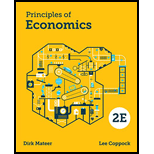
Product Differentiation
Explanation of Solution
Product differentiation is very essential component of monopolistic market. Monopolistic market is an imperfect market situation where a large number of sellers sell their products which are distinct from one another. Product homogeneity leads to close substitutes to a particular product of a firm and this causes the firm to exercise no
In economics, 3 types of product differentiation are found.
- Vertical differentiation: When the customers compare one product on the basis of its quality it's called Vertical differentiation. One example of this scenario is − while purchase of biscuits a consumer can decide between two popular companies' produced biscuits.
- Horizontal differentiation: When products are differentiated in such a way that the consumers cannot easily evaluate them on the basis of their quality only, it's called Horizontal differentiation. In this case, the consumers are not so clear about the quality, so factors other than the quality drive them to compare the differentiated products. For example, when we buy cold drinks; taste, style, flavor, price etc. decide our choice.
- Mixed differentiation: This is the mixture of the 2 former scenarios. Products are differentiated in mixed manner of both vertical and horizontal differentiations in case of highly complex products.
Introduction:
Product Differentiation or simply Differentiation refers to the system of the distinction of a product or service from others in order to make it more attractive and unique in the market. Differentiation is the key characteristic of the monopolistic market. Differentiated products help the firm or company to compete with the other popular and better products.
Want to see more full solutions like this?
Chapter 12 Solutions
Principles of Economics (Second Edition)
- simple steps on how it should look like on excelarrow_forwardConsider options on a stock that does not pay dividends.The stock price is $100 per share, and the risk-free interest rate is 10%.Thestock moves randomly with u=1.25and d=1/u Use Excel to calculate the premium of a10-year call with a strike of $100.arrow_forwardCompute the Fourier sine and cosine transforms of f(x) = e.arrow_forward
- 17. Given that C=$700+0.8Y, I=$300, G=$600, what is Y if Y=C+I+G?arrow_forwardUse the Feynman technique throughout. Assume that you’re explaining the answer to someone who doesn’t know the topic at all. Write explanation in paragraphs and if you use currency use USD currency: 10. What is the mechanism or process that allows the expenditure multiplier to “work” in theKeynesian Cross Model? Explain and show both mathematically and graphically. What isthe underpinning assumption for the process to transpire?arrow_forwardUse the Feynman technique throughout. Assume that you’reexplaining the answer to someone who doesn’t know the topic at all. Write it all in paragraphs: 2. Give an overview of the equation of exchange (EoE) as used by Classical Theory. Now,carefully explain each variable in the EoE. What is meant by the “quantity theory of money”and how is it different from or the same as the equation of exchange?arrow_forward
- Zbsbwhjw8272:shbwhahwh Zbsbwhjw8272:shbwhahwh Zbsbwhjw8272:shbwhahwhZbsbwhjw8272:shbwhahwhZbsbwhjw8272:shbwhahwharrow_forwardUse the Feynman technique throughout. Assume that you’re explaining the answer to someone who doesn’t know the topic at all:arrow_forwardUse the Feynman technique throughout. Assume that you’reexplaining the answer to someone who doesn’t know the topic at all: 4. Draw a Keynesian AD curve in P – Y space and list the shift factors that will shift theKeynesian AD curve upward and to the right. Draw a separate Classical AD curve in P – Yspace and list the shift factors that will shift the Classical AD curve upward and to the right.arrow_forward
 Economics (MindTap Course List)EconomicsISBN:9781337617383Author:Roger A. ArnoldPublisher:Cengage Learning
Economics (MindTap Course List)EconomicsISBN:9781337617383Author:Roger A. ArnoldPublisher:Cengage Learning
 Economics Today and Tomorrow, Student EditionEconomicsISBN:9780078747663Author:McGraw-HillPublisher:Glencoe/McGraw-Hill School Pub Co
Economics Today and Tomorrow, Student EditionEconomicsISBN:9780078747663Author:McGraw-HillPublisher:Glencoe/McGraw-Hill School Pub Co

 Exploring EconomicsEconomicsISBN:9781544336329Author:Robert L. SextonPublisher:SAGE Publications, Inc
Exploring EconomicsEconomicsISBN:9781544336329Author:Robert L. SextonPublisher:SAGE Publications, Inc





